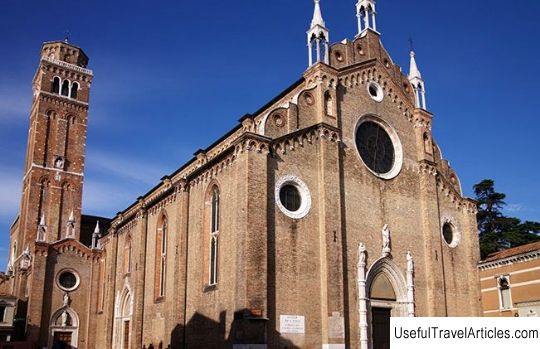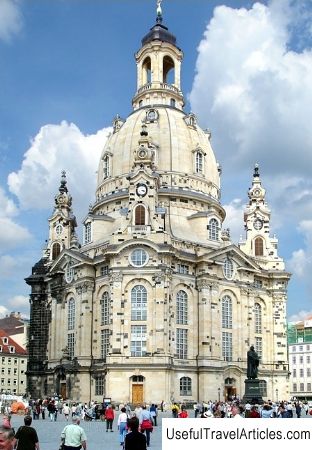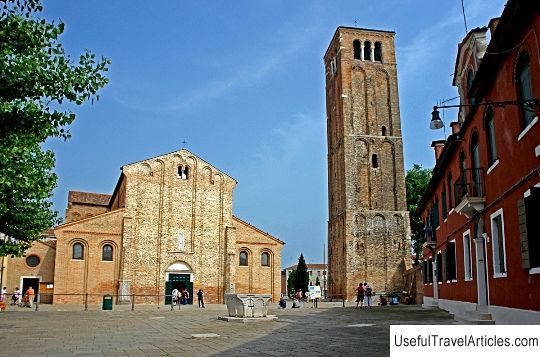Cathedral of Santa Maria Gloriosa dei Frari (Basilica di Santa Maria Gloriosa dei Frari) description and photos - Italy: Venice
Rating: 8,6/10 (500 votes) 
Cathedral of Santa Maria Gloriosa dei Frari (Basilica di Santa Maria Gloriosa dei Frari) description and photos - Italy: Venice. Detailed information about the attraction. Description, photographs and a map showing the nearest significant objects. The title in English is Basilica di Santa Maria Gloriosa dei Frari. Photo and descriptionThe Cathedral of Santa Maria Gloriosa dei Frari, dedicated to the Assumption of the Virgin Mary, is undoubtedly one of the most famous cathedrals in Venice. It stands in the square of the same name in the San Marco quarter. The people often call the cathedral simply Frari. The history of the basilica goes back to the distant 12th century, when a religious movement arose on the territory of the Apennine Peninsula, which had a huge impact on the entire history of Italy and the culture of many peoples. The founder of this teaching was Francis of Assisi. In 1222, his first followers appeared in Venice, who a couple of years later obtained permission from the Doge to build a church. The Franciscans chose the famous Nicolo Pisano as the architect, who built the church and the monastery itself, consecrated in honor of the Most Glorious Virgin Mary (Gloriosa). And the name Frari was given to her by the name of the Franciscans themselves - the smaller brothers, the Minorites, which in Italian sounds like “frati” (over time it was distorted into “frari”). The number of followers of St. Francis of Assisi grew continuously , and already in 1250 it was decided to build a new church, since the old one could not accommodate everyone. However, construction began only in 1330, and was completed more than a hundred years later, in 1443. Half a century later, the cathedral was consecrated in honor of the Assumption of Our Lady. Until 1810, when Napoleon banned religious orders, Santa Maria Gloriosa dei Frari was one of the most popular churches among the people. At the beginning of the 19th century, it became a parish, while retaining the number of parishioners. The first significant restoration was carried out in the cathedral in 1902-1912, and in 1926, in the year of the 700th anniversary of the death of Francis of Assisi, Pope Pius XI granted it the status of a minor basilica. Right from Santa Maria Gloriosa dei Frari is the building of the former monastery "Ca 'Grande dei Frari", which operated for six and a half centuries and gave Italy two Popes - Sixtus IV and Sixtus V. In 1810, the monastery was turned into a barracks, and a couple of years later it was converted into a state archive. Today it contains over 700 million documents relating to the history of Venice. Next to Ca 'Grande dei Frari, you can see the gallery “Abode of the Holy Trinity”, which was designed by Andrea Palladio. The Cathedral of Santa Maria Gloriosa dei Frari itself is built in the form of a Latin cross with a central nave and two side chapels, separated from each other by a colonnade of 12 massive columns. The brick church was built in the Italian Gothic style, and its facade is decorated with capitals, pilasters and pinnacles in the Venetian-Byzantine style. At the main portal of the 14-15th centuries, you can see the snow-white statues of the Resurrection of Christ, the Virgin Mary and Francis of Assisi. There are four more side entrances to the left. In 1396, a 70-meter high brick bell tower was erected next to the cathedral, which is the second highest in Venice after the bell tower of St. Mark's Cathedral. At the very top there is an observation deck, which offers a breathtaking view of the “city on the water.” The interior of the cathedral is decorated with numerous works of art - these are sculptures of saints, monuments to famous Venetians, including doges and generals, paintings by great painters, luxurious altars, stucco and frescoes. Among the sights of the church, it is worth highlighting the monument to the Doge Giovanni Pesaro, made of multi-colored marble in the Baroque style, Titian's paintings "Madonna of Pesaro" and "Assumption of the Virgin Mary" and the grave of Titian himself, a cross with the image of Christ of the 13th century, a wooden statue of John the Baptist by Donatello. In the same cathedral one of the greatest relics of Venice is kept - a crystal vase with the "Holy Blood of Christ", which according to legend was received by Mary Magdalene after the Crucifixion of Christ. This vase was brought to the Apennine Peninsula in 1480 from Constantinople. Also in Santa Maria Gloriosa dei Frari you can see an unexploded Austrian bomb dropped on a church in February 1918.           We also recommend reading Narva Aleksandri kirik (Narva Aleksandri kirik) description and photos - Estonia: Narva Topic: Cathedral of Santa Maria Gloriosa dei Frari (Basilica di Santa Maria Gloriosa dei Frari) description and photos - Italy: Venice. |




